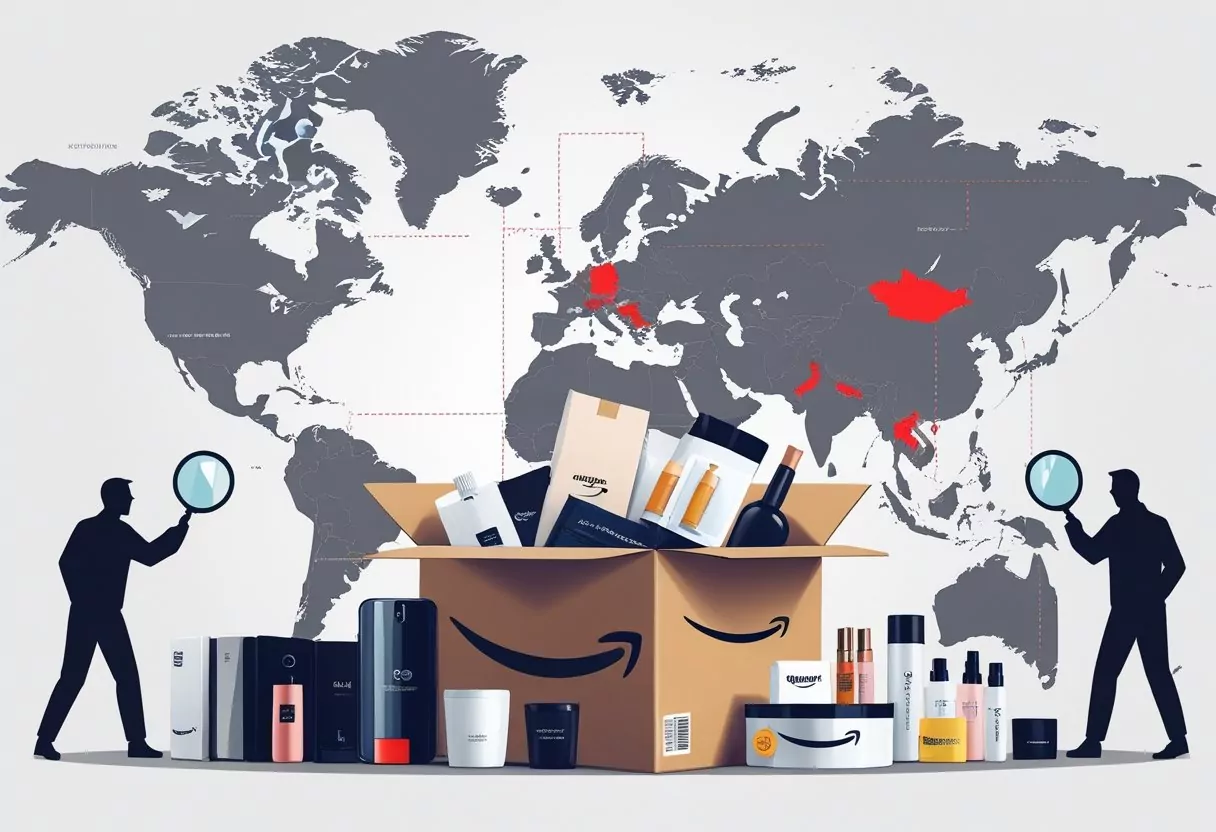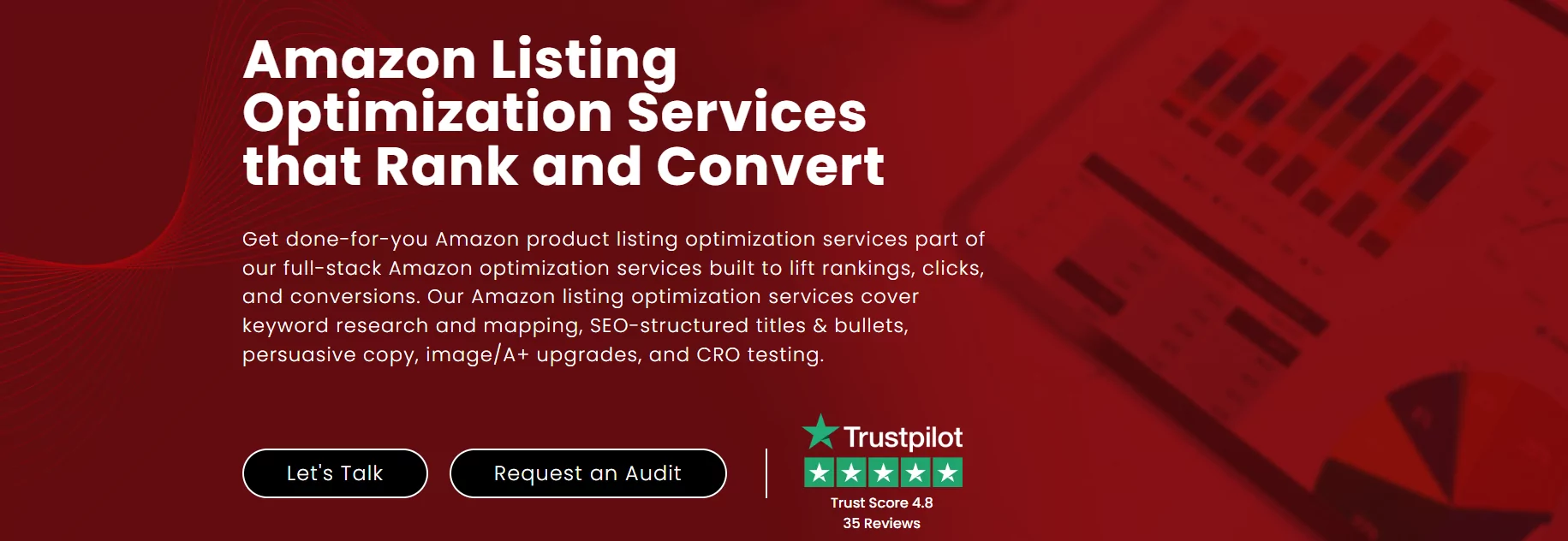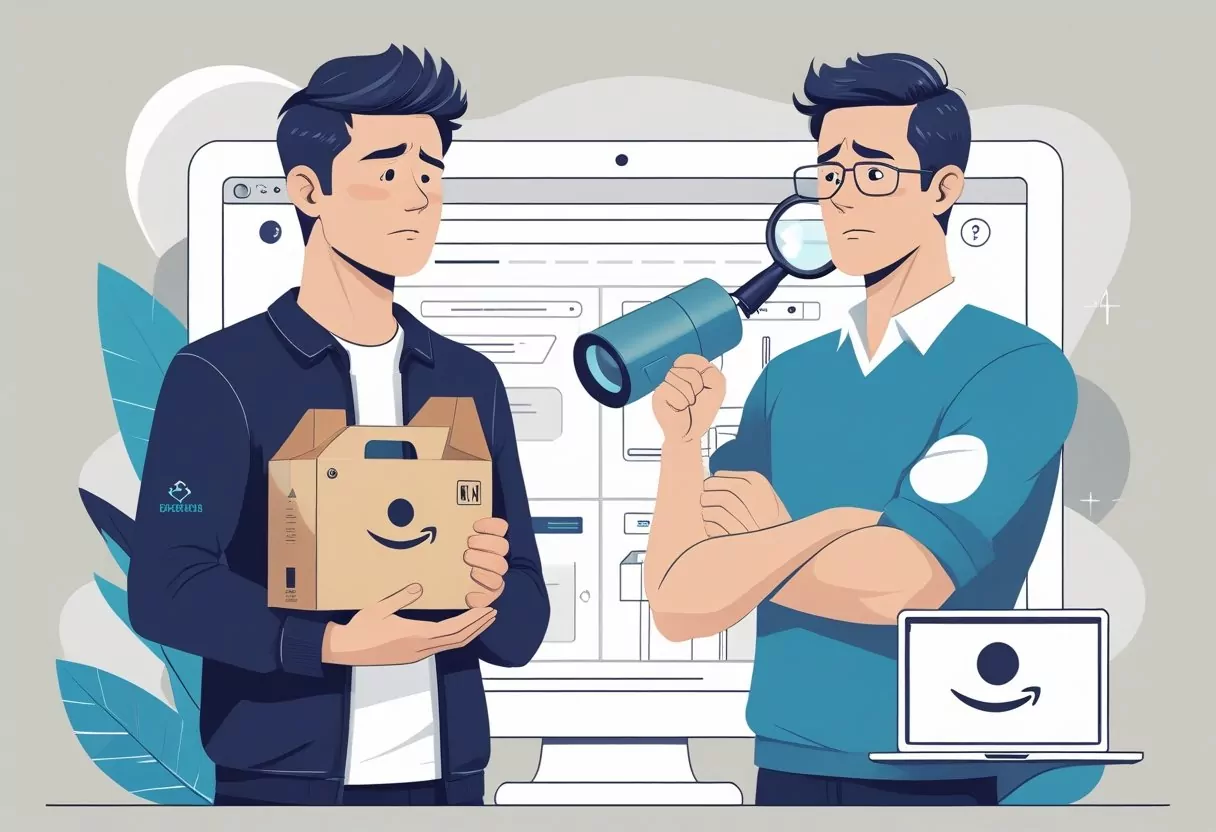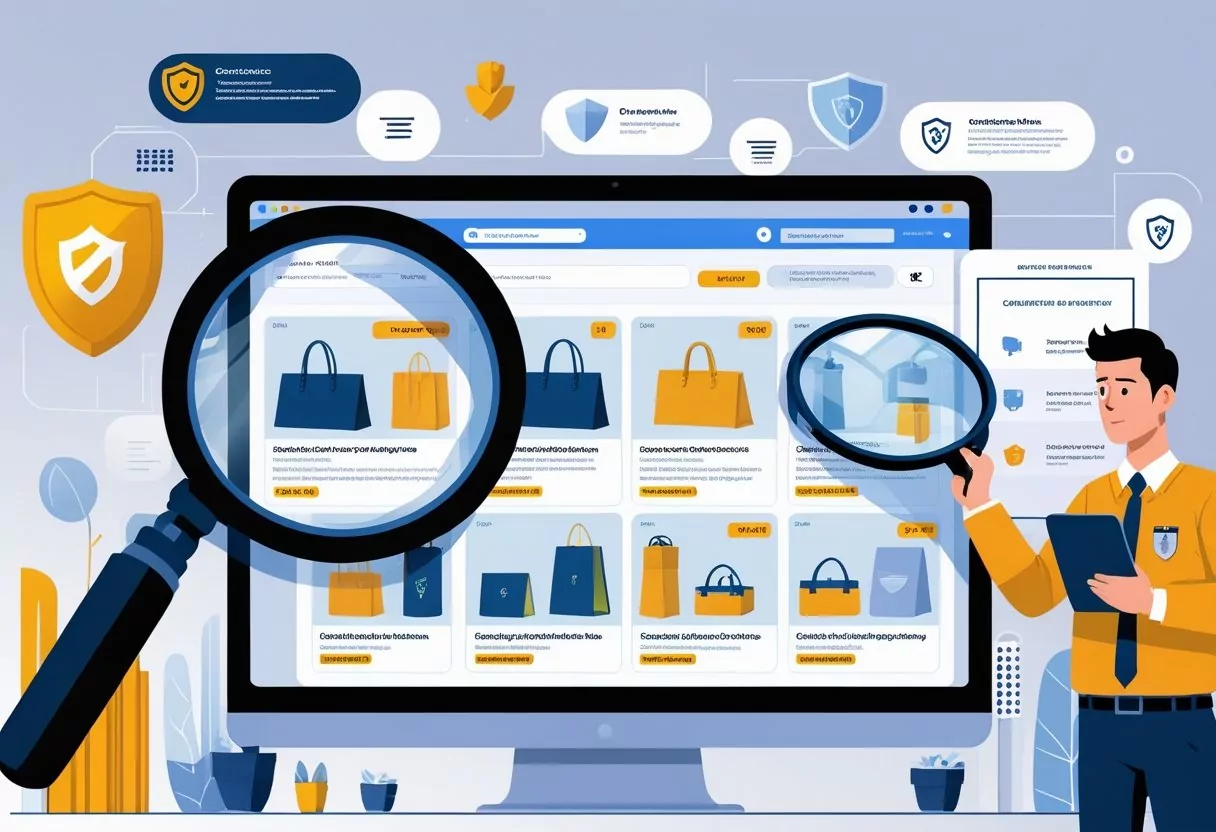Shopping on Amazon gives you access to millions of products from around the world. But this huge marketplace also creates opportunities for sellers to offer fake products on Amazon especially fake shoes alongside real ones.
Counterfeit products have become a major issue on the platform, especially in popular categories like shoes, electronics, and personal care items. While Amazon works to remove fake goods and has banned millions of counterfeit products, many still slip through their detection systems and reach customers who think they’re buying authentic items.
Worldwide Scale of Fake Product Manufacturing
Fake products create massive problems across the globe. Counterfeiters operate in nearly every country and target all types of goods. They copy everything from luxury handbags to electronics to medicines.
Online shopping has made this problem much worse. When you shop on large websites, fake goods can easily mix with real ones. The internet allows counterfeiters to reach millions of customers without much risk.
These fake products hurt both buyers and honest businesses. You might waste money on items that break quickly or don’t work as promised. Real companies lose sales and damage to their reputation when customers buy poor copies of their products.
Law enforcement agencies work hard to stop these criminals, but the problem keeps growing. Counterfeiters often work across borders, making them hard to catch. They use fake company names and addresses to hide their activities.
Learn to stay anonymous as a Tiktok story viewer
The financial impact is enormous. Fake goods cost the global economy billions of dollars each year. They also create safety risks when counterfeiters use cheap, dangerous materials in products like car parts or medical devices.
How Fake Products Harm Buyers and Companies
When you buy counterfeit items, you face several serious problems. These fake products often use cheap materials that break quickly or don’t work properly. You might pay good money but get something that looks nothing like what you expected.
Financial losses hit you in multiple ways:
- You lose money on worthless products
- You may need to buy the real item again
- Return processes can be difficult or impossible
Companies face major damage when counterfeit goods flood the market. Brand owners lose millions in sales when customers choose fake versions instead of authentic products. Patent infringement and copyright infringement create legal battles that cost time and money.
The harm to businesses includes:
- Revenue loss from customers buying fakes
- Brand damage when poor-quality copies disappoint buyers
- Customer service costs from complaints about fake items
- Legal expenses to fight intellectual property infringement
The problem grows worse on online platforms where fake sellers can easily hide. Studies show that counterfeit trade reaches over $460 billion worldwide. This massive market hurts honest businesses and puts you at risk.
Companies must spend heavily on brand protection programs. They register patents and trademarks, then monitor markets for violations. Many hire legal teams specifically to fight counterfeiting operations that steal their designs and logos.
Amazon’s Fight Against Fake Products mainly Fake Shoes
Company Policies and Detection Systems
Amazon maintains strict rules that ban all non-authentic products from their platform. The company uses a zero-tolerance approach when dealing with sellers who list fake items.
Their detection systems use AI technology to scan millions of listings. These automated tools caught over 99% of suspected fake products before brands even needed to report them. The system analyzes product details, seller information, and customer reviews to spot potential counterfeits.
Amazon also runs background checks on sellers before they can start selling. New sellers must verify their identity and provide business documents. This process helps keep fraudulent sellers off the platform.
The company works with law enforcement agencies worldwide. In 2023, these partnerships led to raids and seizures that removed millions of fake products from warehouses. Amazon’s counterfeit crimes unit helps brands and police investigate sellers who break the rules.
Key Detection Methods:
- AI-powered listing analysis
- Seller verification processes
- Brand owner reporting tools
- Law enforcement partnerships
When Amazon finds fake products, they remove the listings immediately. Sellers face account suspension or permanent bans. The company also destroys seized counterfeit items to prevent them from reaching customers.
Work with a result driven Amazon Advertising Agency and grow your ROAS in no time
Brand Protection Through Registry Programs
The Amazon Brand Registry gives you powerful tools to protect your products. This program lets trademark owners control how their brands appear on the platform.
You can register your trademarks with Amazon to gain access to special features. The transparency program works alongside Brand Registry to add extra security layers to your products.
Registry Benefits for Brand Owners:
| Feature | Description |
|---|---|
| Proactive Monitoring | Amazon scans for counterfeit listings using your trademark data |
| Quick Removal Tools | Report fake products through streamlined systems |
| Enhanced Search | Find unauthorized sellers using your brand name |
| Analytics Access | Track how counterfeiters target your products |
The registry program helps you remove counterfeit products faster than standard reporting methods. You get priority review for takedown requests and direct communication channels with Amazon’s brand protection team.
Project Zero gives enrolled brands even more control. This advanced program lets you directly remove listings that violate your intellectual property rights without waiting for Amazon’s review.
Brand Registry requires active participation from you. You need to monitor your listings regularly and report suspicious activity. The program works best when brand owners stay engaged and use all available tools.
The system also provides data about counterfeit trends affecting your brand. You can see which products get copied most often and adjust your protection strategies accordingly.
How to Spot Counterfeit Shoes on Amazon
Ways to Identify Fake Shoes
Several clear signs can help you detect fake shoes before making a purchase. Start by comparing prices across different platforms.
Authentic shoes maintain consistent pricing across retail stores and official brand websites. When you see shoes priced much lower than normal retail value, this raises concern about authenticity.
Seller verification matters greatly. Check if the item shows “sold by” the actual brand or manufacturer on the product page. Items sold and shipped directly by Amazon have lower counterfeit risk.
| What to Check | Authentic Signs | Counterfeit Red Flags |
|---|---|---|
| Price | Matches retail stores | Much cheaper than normal |
| Seller | Brand name or Amazon | Unknown third-party sellers |
| Images | Clear, professional photos | Blurry or low-quality images |
| Details | Accurate product descriptions | Missing or incorrect information |
Examine product images carefully. Authentic shoes feature high-quality photos that show clear details of stitching, logos, and materials. Poor image quality often indicates sellers trying to hide product flaws.
Pay attention to specific details:
- Logo placement and size
- Stitching patterns and quality
- Material texture and color
- Sole thickness and design
- Packaging appearance
Check the product description for spelling errors or missing information. Legitimate sellers provide complete details about materials, sizing, and care instructions.
Look for official certifications or authenticity guarantees when available. Some brands include special tags or verification codes with genuine products.
Why Customer Reviews and Purchase Verification Matter
Customer reviews provide valuable insights about shoe authenticity and quality. Focus on reviews that include photos of the actual received products.
Verified purchase badges show real customer experiences. These reviews come from people who actually bought the item through Amazon, making them more trustworthy than unverified reviews.
Read reviews that mention specific details about the shoes. Customers often point out differences they noticed compared to authentic versions they own.
Look for patterns in multiple reviews. When several customers report similar issues like poor stitching, wrong materials, or packaging problems, these patterns suggest counterfeit products.
Review analysis tips:
- Read both positive and negative feedback
- Check review dates for recent experiences
- Look for detailed descriptions rather than brief comments
- Notice if reviewers mention authenticity concerns
Photos in reviews show real product appearance. Compare these customer photos with official brand images to spot differences in logos, colors, or construction.
Pay attention to reviews mentioning return experiences. Customers who received fake products often share their refund process, helping you understand the seller’s response to counterfeit complaints.
Skyrocket Your Sales with Expert Amazon PPC Management Services
What to Do When You Get a Fake Product
Actions to Take When You Think Your Amazon Purchase Is Counterfeit
Stop using the product right away. Fake items can be dangerous and may not work properly.
Check the product carefully. Look at the packaging, labels, and the item itself. Compare them to photos of real products online. Take pictures of anything that looks wrong.
Contact the seller first through your Amazon account. Send them a message explaining the problem. Give them a chance to fix the issue.
File an A-to-z Guarantee claim if the seller doesn’t help you. Amazon offers this protection for buyers who get fake or damaged items.
| Step | Action | Why It Matters |
|---|---|---|
| 1 | Stop using the item | Safety first |
| 2 | Document problems | Evidence for claims |
| 3 | Contact seller | Quick resolution |
| 4 | File Amazon claim | Buyer protection |
Keep all your purchase records. Save emails, order numbers, and photos. You’ll need these if you have to prove your case.
Contact your credit card company if Amazon can’t help. Many cards offer purchase protection for counterfeit items.
How to Report Fake Products to Amazon and Get Your Money Back
Log into your Amazon account and go to your order history. Find the fake item you bought.
Click “Return or replace items” next to your order. Choose “Product not as described” as your reason. Explain that the item is fake in the comments box.
Amazon will review your request within 24-48 hours. They may ask for more proof like photos or receipts.
Use Amazon’s Report a Violation tool if you’re a brand owner. This tool helps companies find and report fake versions of their products.
Most refund requests for counterfeit items get approved quickly. Amazon wants to protect buyers and remove bad sellers.
Leave an honest review after you report the fake item. This warns other buyers about the problem. Don’t use harsh language, just state the facts.
Contact Amazon customer service directly if the automatic system doesn’t help. Call or chat with them to explain your situation.
Amazon may remove the fake listing and suspend the seller’s account. Your report helps protect other buyers from getting tricked.
You should get your refund within 3-5 business days after Amazon approves your claim. The money goes back to your original payment method.
Ways to Stay Safe From Fake Products
Smart Shopping Strategies for Amazon
Shopping safely on Amazon requires careful attention to seller details. Focus on vendors with strong customer ratings and many positive reviews. These sellers typically have proven records of delivering real products.
Key factors to check before buying:
- Seller ratings (aim for 95% or higher)
- Number of reviews (more reviews usually mean more reliability)
- How long the seller has been active on Amazon
Research whether the seller is approved by the brand you want to buy. Most brands list their official dealers on their websites. This simple step helps you avoid fake products.
Get done-for-you Amazon product listing optimization services today
Study product photos and descriptions carefully. Compare them with the brand’s official website or other trusted sources. Watch for these warning signs:
| Red Flag | What to Look For |
|---|---|
| Poor image quality | Blurry or pixelated photos |
| Wrong details | Missing features or wrong colors |
| Price differences | Much lower than normal retail price |
Check the return policy before you buy. Legitimate sellers offer clear return options. Sellers with confusing or missing return policies may be selling fakes.
Take time to verify sellers and products before clicking “buy now.” This extra effort protects you from counterfeit items and saves money in the long run.
Why Brand Stores and Official Dealers Work Best – Know especially if you are buying baume schuhe amazon
Buying from brand stores or approved retailers gives you major advantages. These sources guarantee you get real products every time.
Product guarantees come standard with official purchases. Approved retailers provide warranties that cover repairs or replacements if something goes wrong. Third-party sellers rarely offer these protections.
Customer support from brand stores is superior. Staff members know the products well and can answer your questions accurately. They help you find exactly what you need.
Access to special releases is another benefit. Brands often launch new or limited items only through their own stores and approved partners. You miss these opportunities when shopping elsewhere.
Your purchase supports the company directly when you buy from official sources. This funding helps brands create better products and maintain quality standards.
Brand stores also offer the most current product lines and accurate sizing information. You avoid outdated inventory that sometimes appears with unauthorized sellers.
Final Thoughts
Fake products on shopping sites create real problems for buyers and companies. You face risks when you buy items that aren’t genuine.
Your Role as a Smart Shopper:
- Check seller ratings before buying
- Look for official brand stores
- Read product reviews carefully
- Report fake items when you find them
Amazon uses technology to block most fake listings before they go live. The company removed millions of counterfeit products in recent years. However, some fake items still get through their systems.
What You Can Do:
- Buy from trusted sellers
- Avoid deals that seem too good to be true
- Contact customer service if something looks wrong
When you purchase fake products, you put yourself at risk. These items may not work properly or could be unsafe. You also hurt real brands when you buy copies of their products.
Your shopping choices matter. Each time you pick a genuine product over a fake one, you help solve this problem.
Common Questions and Answers
If you’re searching things like “does Amazon sell fake shoes,” “fake shoes on Amazon,” or “does Amazon sell fake products,” you’re not really looking for drama, you’re trying to avoid wasting money and getting stuck with the wrong pair.
People also end up typing brand-specific queries like “does Amazon sell fake Skechers” or validation searches like “walkstk shoes reviews Amazon” because they want a quick trust signal before they hit “Buy Now.”
The reality is that Amazon has plenty of legitimate listings, but because many items are sold by third-party sellers, shoppers still wonder “does Amazon sell fake products?” and “how can I tell if shoes on Amazon are authentic?”
The safest move is simple: check whether it’s ships from and sold by Amazon or the official brand storefront, compare pricing to the brand’s usual retail price, scan recent reviews for consistency (not just the star rating). Furthermore, make sure the return policy is clear, especially when the search looks niche like “stylishhoe amazon” or “baume schuhe amazon,” where the listing quality and seller credibility matter even more.
1) Does Amazon sell fake shoes?
It can happen, mainly through third-party sellers—so your job is to reduce risk by buying from Amazon directly, the brand store, or reputable authorized sellers.
2) Does Amazon sell fake Skechers?
Most listings are genuine, but fakes and misleading listings can appear. Always verify the seller, compare model/style details, and avoid prices that look unreal.
3) How can I tell if shoes on Amazon are authentic (and avoid fake shoes on Amazon)?
Check “sold by” details, return policy, recent reviews, product photos/specs, and packaging details on arrival, if anything feels off, return immediately and report the listing.
4) How does Amazon identify and stop fake products from being sold?
Amazon uses several methods to catch fake items before they reach customers. The company scans product listings using computer programs that look for suspicious details.
Detection Methods:
- Image analysis – Software checks product photos for signs of counterfeiting
- Brand verification – Sellers must prove they have permission to sell certain brands
- Customer reports – Buyers can flag items they think are fake
- Purchase monitoring – Amazon tracks buying patterns to spot unusual activity
Amazon also works with the Counterfeit Crimes Unit. This team investigates sellers and works with police to stop bad actors.
5) What steps should I take if I think I got a fake product?
You should act quickly if you believe your purchase is counterfeit. Amazon has specific ways to handle these situations.
Immediate Actions:
- Report the item – Go to your order history and select “Report a problem”
- Take photos – Document the product, packaging, and any obvious differences
- Keep everything – Save the item, box, and any paperwork
- Contact customer service – Use Amazon’s chat or phone support
You can usually get a refund or replacement. Amazon may also remove the listing to protect other buyers.
6) Can I file a complaint against a seller selling fake goods?
Yes, you can report sellers who you believe are selling counterfeit items. Amazon takes these reports seriously and investigates each claim.
Reporting Process:
- Find the seller’s profile page
- Click “Report abuse” or similar option
- Choose “Counterfeit products” as the reason
- Provide details about why you think the item is fake
Amazon may suspend or ban sellers who violate their policies. Your report helps protect other customers from getting scammed.
7) What rules and punishments exist for sellers caught with fake merchandise?
Amazon has strict rules about authentic products. Sellers who break these rules face serious consequences.
| Violation Level | Penalty |
|---|---|
| First offense | Warning and training requirement |
| Repeat violations | Account suspension |
| Serious cases | Permanent ban and legal action |
Policy Requirements:
- All products must be genuine and legally obtained
- Sellers need invoices proving where items came from
- Brand authorization letters may be required
- No modified or altered products allowed
Amazon may also take legal action through their Counterfeit Crimes Unit for serious cases.
8) How does Amazon work with companies to verify real products?
Amazon partners with brands to make sure only authentic items get sold. These partnerships help catch fakes faster.
Brand Protection Programs:
- Brand Registry – Companies can register trademarks and monitor listings
- Transparency Program – Products get special codes that prove they’re real
- Project Zero – Brands can remove fake listings themselves
Brands can also share information about their products with Amazon. This helps the computer systems learn what real items should look like.
9) Is Amazon selling counterfeit products?
Amazon doesn’t intentionally sell counterfeits as a policy, but because its marketplace includes millions of third-party sellers, counterfeit or fake items sometimes slip through.
Counterfeit goods reportedly show up in many categories, from cosmetics and electronics to branded apparel — especially from sellers who exploit weak oversight.
The fact that Amazon itself has a dedicated team to fight counterfeits — Amazon Counterfeit Crimes Unit (CCU) strongly suggests that fake products are a real problem on the platform.
So: yes, sometimes Amazon does end up selling counterfeit products.
10) How to tell if Amazon is selling fake products
Here are common red flags you can watch out for to spot potential fakes on Amazon:
Price is suspiciously low , if a “luxury” or high-value item is much cheaper than usual retail, that’s a warning sign.
Seller is unknown or based overseas, especially via third-party sellers — many counterfeit problems come from lesser-known sellers rather than from official brand stores.
Packaging, materials or finishing look “off”, fake items sometimes have spelling errors, weird packaging, lower-quality materials, or slightly different design compared to the real product.
Too many reviews or overly positive reviews that seem generic, counterfeit listings may rely on fake or manipulated reviews to boost perceived legitimacy.
Reviews mention words such as “fake”, “counterfeit”, or “cheap”, sometimes past buyers explicitly call out the product as fake.
A good rule: when possible, buy direct from the brand’s official store or from sellers with strong reputations and transparent history.
11) Are Amazon products sometimes fake?
Yes, absolutely sometimes. Because Amazon supports a vast network of independent sellers, there will always be a risk of counterfeit or fake products appearing. Even items sold as “new” or “original” have been reported fake.
That said, not all Amazon products are fake, millions of transactions happen safely and legitimately. Amazon’s anti-counterfeit efforts (like seizure operations, its CCU, listing vetting) aim to reduce this risk.
12) What percentage of Amazon products are counterfeit?
Answer: nobody knows for sure.
Some sources claim “as many as 10–60% of listings could be counterfeit,” especially in categories prone to fakes (luxury, electronics, etc.).
Others argue the rate is far lower, one estimate puts it at 0.01% of all products in 2022.
Because Amazon doesn’t (publicly) guarantee authenticity for every listing, and because the marketplace constantly changes, any figure is speculative. As one anti-counterfeiting-industry report notes, it’s “statistically low” but “the issue persists.”
In short: some research suggests a tiny fraction is counterfeit, but among high-risk categories, the share could be much higher.
My take, Amazon: mostly legit, but be vigilant
Amazon remains a convenient, powerful place to shop, but because it’s partly a multi-seller marketplace, you need to shop smart. Always check the seller, reviews, packaging, and price. Especially for expensive, brand-name or high-risk items (cosmetics, electronics, luxury goods) — being cautious can save you from getting a fake.
13) What extra protection exists during big sales and events?
Amazon increases security measures during major sales events when more people shop online. These times often see more attempts to sell fake products.
Enhanced Protections:
- More staff monitoring listings
- Faster response to customer reports
- Extra checks on new seller accounts
- Increased partnership with law enforcement
Your Protection:
- Same return policies apply
- Customer service has extended hours
- Reports get priority handling
- Refunds process normally
You should still check seller ratings and reviews carefully during these busy times. Popular items often attract counterfeit sellers.





